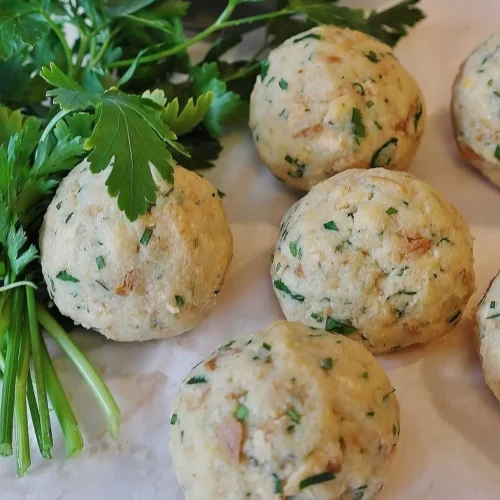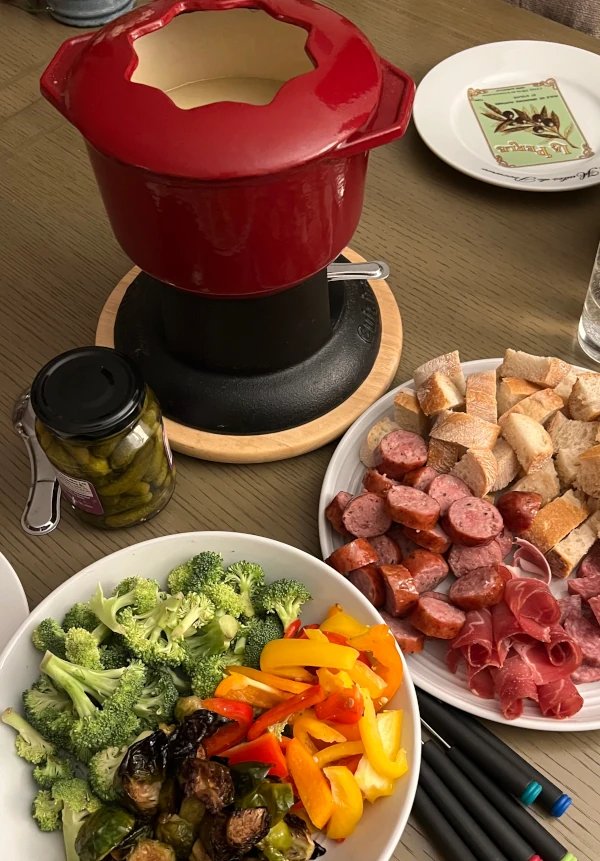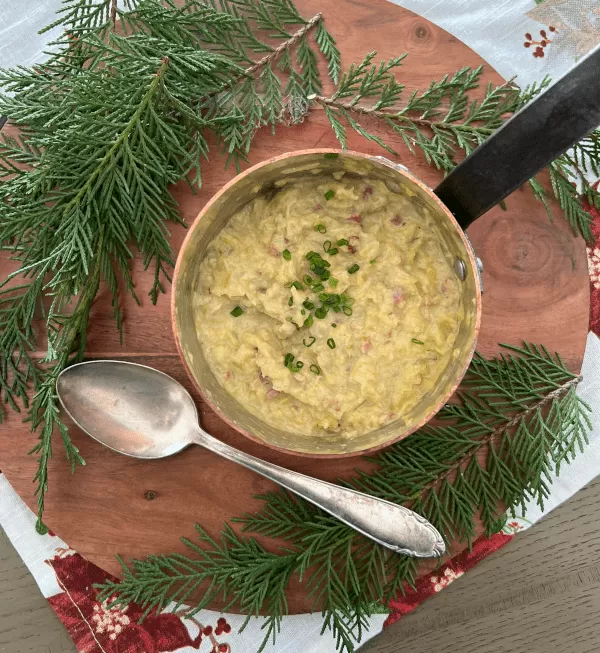Semmelknödel, or bread dumplings, are a beloved staple in German cuisine, particularly in the regions of Bavaria and Austria. These dumplings are a perfect example of resourcefulness in the kitchen, as they make excellent use of leftover bread. Whether you’re serving them as a side dish or as part of a hearty main course, Semmelknödel offer a satisfying and flavorful experience that’s often preferred over potato dumplings. In this post, I’ll discuss the history and variations of Semmelknödel, provide a detailed recipe, and discuss how they can be adapted to include different types of bread and even stale pretzels. This is a classic German side dish and something that is pretty easy to make. I think it’s easier to make than potato dumplings and many people I know agree!

The Resourcefulness of Bread Dumplings
Bread has always been a central element in German cuisine, and with good reason. German bread, known for its variety and quality, is often enjoyed fresh. However, when it becomes stale, rather than letting it go to waste, it is transformed into something new and delicious—Semmelknödel. The name “Semmelknödel” comes from “Semmel,” a Southern German and Austrian word for bread roll, and “Knödel,” meaning dumpling.
These bread dumplings are not just a way to use up leftover bread; they are a cherished dish in their own right. In fact, many people prefer Semmelknödel to potato dumplings, citing their light, fluffy texture and the way they absorb sauces and gravies.
Making Bread Dumplings
Making Semmelknödel is straightforward, and the ingredients are likely ones you already have in your kitchen. The one mistake many people make is with the water. You DO NOT want it boiling hard! The dumplings will fall apart in the water and be a mess and possibly ruin your day haha. Follow these steps though and you’ll have an almost foolproof recipe. Here’s how you can make this classic dish:
Bread Dumpling Ingredients:
- 8 stale bread rolls (about 400g), cut into small cubes
- 1 1/2 cups hot milk (about 350ml)
- 1 medium onion, finely chopped
- 2 tbsp butter (for sautéing the onions)
- 2 tbsp fresh parsley, chopped
- 2 large eggs
- 1 tsp salt
- 1/2 tsp freshly ground pepper
- 1/4 tsp ground nutmeg
Instructions:
- Prepare the Bread: Start by cutting your stale bread rolls into small cubes. If the bread isn’t quite stale enough, you can dry it out slightly by leaving it uncovered for a few hours or toasting it lightly in the oven. Place the bread cubes in a large mixing bowl.
- Soak the Bread: Pour the hot milk over the bread cubes, making sure all the bread is moistened. Stir to combine and let the mixture sit for about 15 minutes, allowing the bread to absorb the milk fully. The bread should become soft but not mushy.
- Sauté the Onions: While the bread is soaking, melt the butter in a skillet over medium heat. Add the finely chopped onions and sauté until they are soft and translucent, about 5 minutes. Remove the onions from the heat and let them cool slightly.
- Combine the Ingredients: Add the sautéed onions, fresh parsley, eggs, salt, pepper, and nutmeg to the soaked bread mixture. Mix thoroughly until all the ingredients are well combined. The mixture should be moist but firm enough to hold its shape when formed into dumplings.
- Shape the Dumplings: With damp hands, form the mixture into 8-10 round dumplings, ensuring they are compact and well-formed. If the mixture is too dry and crumbly, you can add a little more milk. If it’s too wet, add a bit of breadcrumbs.
- Cook the Dumplings: Bring a large pot of salted water to a gentle simmer (not boiling). Carefully place the dumplings into the water and cook for about 15-20 minutes. The dumplings are done when they float to the surface and are firm to the touch. Avoid boiling the water too vigorously, as this can cause the dumplings to break apart.
- Serve and Enjoy: Remove the dumplings with a slotted spoon and serve hot. Semmelknödel are traditionally served with rich sauces, like those found in Rahmschwammerl (creamy mushroom stew), or alongside roasted meats and gravy.
Variations on a Classic
One of the joys of making Semmelknödel is that they can be easily adapted to suit your tastes or to make use of whatever bread you have on hand. While the traditional version uses plain white bread rolls, you can experiment with different types of bread to create unique flavors and textures. I tend to not like the seeded varieties and whole grain breads as much but that can be a personal preference. By all means give it a shot. Maybe you’ll love it!
- Stale Pretzels: For a Bavarian twist, try using stale pretzels instead of bread rolls. The salty, chewy pretzels add a distinctive flavor and texture to the dumplings, making them a perfect match for hearty dishes like pork knuckles or bratwurst.
- Rye and Pumpernickel: This hearty German Bauernbrot or pumpernickel can also be used to make a darker, denser dumpling. These breads impart a deep, earthy flavor that pairs well with robust meats and savory gravies.
- Tyrolean Style with Speck: In the Tyrolean Alps, a popular variation includes finely chopped Speck (a type of cured, smoked ham) mixed into the dough. This adds a smoky, savory flavor to the dumplings, making them a perfect side dish for sauerkraut or roasted pork. I will have this recipe so make sure you subscribe to be informed of all new recipes!
- Serviettenknödel: Another variation is the Serviettenknödel, which is a large bread dumpling cooked in a cloth napkin or a sausage casing, then sliced into rounds. This version is often served with venison or other game meats, making for an elegant presentation.
Serving Suggestions: Rahmschwammerl and More
Semmelknödel are incredibly versatile and can be served with a wide range of dishes. One of the most popular pairings is with Rahmschwammerl, a creamy mushroom stew that perfectly complements the dumplings. The rich, velvety sauce seeps into the dumplings, creating a mouthwatering combination that’s both comforting and satisfying.
Another classic pairing is with Sauerbraten, a marinated pot roast that’s a specialty in many regions of Germany. The tender meat and tangy gravy are the perfect foil for the soft, pillowy dumplings. Of course, Semmelknödel can also be enjoyed on their own, perhaps with a drizzle of melted butter and a sprinkle of fresh herbs.
A Dish Rooted in Tradition
Semmelknödel are more than just a way to use up leftover bread; they are a testament to the ingenuity and resourcefulness of German cooks. Over the centuries, these dumplings have become a beloved part of the culinary landscape, cherished for their simplicity, versatility, and, above all, their deliciousness.
Whether you’re making them for the first time or continuing a family tradition, Semmelknödel are a dish that brings comfort and joy to the table. So the next time you find yourself with some stale bread, don’t throw it away—turn it into something special with this classic recipe.
In conclusion, Semmelknödel offer a delightful way to enjoy the flavors of Germany in your own home. With their light texture, adaptability, and ability to soak up rich sauces, they have earned their place as a favorite among dumpling lovers. Whether paired with Rahmschwammerl, served alongside roasted meats, or enjoyed on their own, these bread dumplings are sure to become a staple in your kitchen. So, gather your ingredients, roll up your sleeves, and start making some Semmelknödel—your taste buds will thank you!

Semmelknoedel – German Bread Dumplings
Ingredients
- 8 stale bread rolls about 400g, cut into small cubes
- 1 1/2 cups hot milk about 350ml
- 1 medium onion finely chopped
- 2 tbsp butter for sautéing the onions
- 2 tbsp fresh parsley chopped
- 2 large eggs
- 1 tsp salt
- 1/2 tsp freshly ground pepper
- 1/4 tsp ground nutmeg
Instructions
- Place the cubed bread rolls in a large mixing bowl. Pour the hot milk over the bread, stir to combine, and let it soak for about 15 minutes until the bread is soft.
- In a skillet, melt the butter over medium heat. Add the chopped onions and sauté until they are soft and translucent, about 5 minutes. Remove from heat and allow to cool slightly.
- Add the sautéed onions, fresh parsley, eggs, salt, pepper, and nutmeg to the soaked bread mixture. Mix thoroughly until all the ingredients are well combined.
- With damp hands, form the mixture into 8-10 round dumplings, ensuring they are compact.
- Bring a large pot of salted water to a gentle simmer (not boiling). Carefully place the dumplings into the water and cook for about 15-20 minutes, or until they float to the surface and are firm to the touch.
- Remove the dumplings with a slotted spoon and serve hot.
Notes
FAQ: Semmelknödel
1. Can I make Semmelknödel ahead of time?
Yes, you can prepare the Semmelknödel mixture a few hours in advance and store it in the refrigerator until you’re ready to cook them. Once cooked, they can be kept warm in a low oven or reheated in a steamer or microwave. Leftover dumplings can also be sliced and fried in butter for a delicious variation.
2. What can I use if I don’t have stale bread rolls?
If you don’t have stale bread rolls, you can use any type of firm bread, such as baguettes or country-style bread. If your bread isn’t stale, you can dry it out by toasting the cubes lightly in the oven or leaving them uncovered for a few hours.
3. Can I freeze Semmelknödel?
Yes, Semmelknödel can be frozen either before or after cooking. To freeze before cooking, shape the dumplings and place them on a baking sheet to freeze individually before transferring them to a freezer bag. When ready to cook, add them directly to simmering water without thawing. To freeze after cooking, allow the dumplings to cool completely before freezing them in an airtight container. Reheat by steaming or microwaving.
4. What are some common variations of Semmelknödel?
Common variations include using stale pretzels, rye bread, or pumpernickel instead of bread rolls. You can also add ingredients like Speck (cured ham) for a Tyrolean twist, or make Serviettenknödel, where the dumpling mixture is cooked in a cloth and sliced. Each variation offers a unique flavor and texture.
5. What dishes pair well with Semmelknödel?
Semmelknödel pair beautifully with rich, saucy dishes like Rahmschwammerl (creamy mushroom stew), Sauerbraten (marinated pot roast), and any roasted meats with gravy. They also work well with vegetarian dishes, such as creamy spinach or roasted vegetables. You can even enjoy them on their own with a drizzle of melted butter and fresh herbs.




